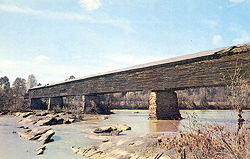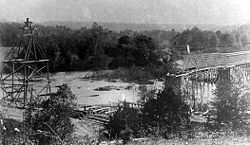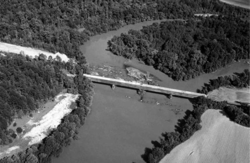Miller's Ferry Bridge
The Miller's Ferry Bridge, also called Miller Covered Bridge or Horseshoe Bend Bridge, was a 600-foot, four-span wooden covered bridge spanning the Tallapoosa River east of Alexander City, at the former site of Miller's Ferry (Alabama State Highway 49). It was built in 1908 by Joe Winn of Dadeville for $13,986, paid for by Tallapoosa County.
The bridge, once the longest covered bridge in the United States, was constructed using the Town lattice truss, a type patented by Ithiel Town of Connecticut in 1820. The bridge incorporated more than 1,600 White oak pegs. Iron-framed approach spans extended the apparent length of the bridge beyond the bank abutments.
The site of the bridge was at Horseshoe Bend, the site of the culminating battle fought by Andrew Jackson to end then Creek Indian War against the Creek Nation. The area is now part of the Horseshoe Bend National Military Park.
A new concrete bridge was constructed parallel to the covered bridge in the late 1950s. The Horseshoe Bend Bridge was washed out by floodwaters following heavy rains in June 1963. The stone abutments can still be seen at the crossing, just north of the present Highway 49.
References
- Prince, A. G. (1981) Alabama's Covered Bridges: Past and Present. revised edition. Ensley: Best Printing Service
External links
- Miller Covered Bridge at nps.gov


